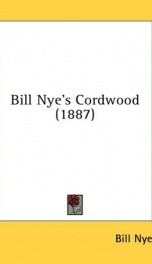Nye Bill
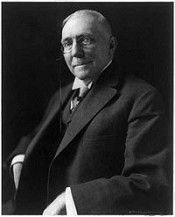
James Whitcomb Riley (October 7, 1849 – July 22, 1916) was an American writer and poet. Known as the Hoosier Poet, National Poet,[1] and the Children's Poet,[2] he started his career in 1875 writing newspaper verse in Indiana dialect for the Indianapolis Journal. His verse tended to be humorous or sentimental, and of the approximately one thousand poems that Riley published, over half are in dialect. Claiming that "simple sentiments that come direct from the heart"[3] were the reason for his success, Riley vended verse about ordinary topics that were "heart high."[4] Riley was a bestselling author during the early 1900s and earned a steady income from royalties; he also traveled and gave public readings of his poetry. His favorite authors were Robert Burns and Charles Dickens, and Riley himself befriended bestselling Indiana authors such as Booth Tarkington, George Ade and Meredith Nicholson. Many of his works were illustrated by the popular illustrator Howard Chandler Christy. James Whitcomb Riley was born on October 7, 1847, in Greenfield, Indiana, to local attorney Reuben A. Riley and his wife, Elizabeth (Marine) Riley, in a small cabin. His parents named him after James Whitcomb, the governor of Indiana. James Whitcomb Riley was their third child. He lived on the same property until he was 21. Riley was influenced by many of the visitors to his father's home. In particular, he was able to pick up the cadence and character of the dialect of central Indiana and the travelers along the old National Road, which came through in the many poems he went on to write. One particular visitor was Mary Alice Smith, who eventually stayed on to live with the Rileys. Mary Alice (Allie) Smith influenced Riley's poem Little Orphant Annie, which was originally to be called Little Orphant Allie but a typesetter's error changed the name of the poem.[5] Riley was never a great student. Before he dropped out of school at age 16, a former teacher encouraged him to appreciate nature. He attempted to study law in his father's law office, however he found that the law was not for him, whereupon he took several different jobs in rapid succession.[5] Riley wrote his first poem in 1870 when he was 21. He began writing for several newspapers, eventually working for the Indianapolis Journal in Indianapolis, Indiana writing miscellaneous articles, versifying whenever possible.[5] Riley's big break came with the private publishing of a thousand copies of The Old Swimmin' Hole and 'Leven More Poems in 1883 under the pseudonym of "Benjamin F. Johnson, of Boone". The book rapidly sold all of the first printing, causing Indianapolis book publisher Merrill, Meigs and Company to quickly contract with Riley to publish the second edition of The Old Swimmin' Hole and 'Leven More Poems. Riley continued to work with the publishing company which eventually became Bowen-Merrill and finally Bobbs-Merrill. The 1886 publishing The Boss Girl began to publish new Riley literature regularly. As a result he began to tour the United States giving lectures, starting in the mid-1880s.[5] In 1893 he was invited to live at the residence of Charles and Magdalena Holstein within the Indianapolis neighborhood of Lockerbie. He would call this his permanent residence for the last 23 years of his life, although he eventually purchased his childhood home, and allowed his brother, John Riley, to live there.[5] Riley was in demand throughout his life, including being a guest at the White House. He was elected to the American Academy of Arts and Letters. In 1912 the National Institute of Arts and Letters gave him the gold medal of poetry, the first poet so honored. He also received several honorary degrees.[5] Riley loved children but he never had any of his own; he also never married. Evidence points that he regretted his bachelorhood and childlessness. Many believe that his poems about and for children were written due to this regret. Others attribute his poems to his regrets over alcoholism and his possible affliction with syphilis.[6] In 1902, Riley wrote the poem "America, Messiah of Nations" the dedication of the Soldiers' and Sailors' Monument, and he read it at the dedication ceremonies. Indiana honored Riley after his death in 1916 by burying him in Crown Hill Cemetery in Indianapolis. The site of his grave is atop Strawberry Hill, the highest point in Indianapolis, offering a spectacular view of the city. Although Riley's poetry has fallen out of popularity, a few of his poems, such as Little Orphant Annie and Lockerbie Street, continue to be taught. In 1916 a group of prominent citizens from Indianapolis organized the Riley Memorial Association (now the Riley Children's Foundation) to build a children's hospital in memory of the Hoosier Poet. The James Whitcomb Riley Hospital for Children opened in 1924. The foundation also purchased the poet's home in his later years in downtown Indianapolis; it is maintained as a museum and today. The James Whitcomb Riley Museum Home is the only late-Victorian home in Indiana that is open to the public and the country's only late-Victorian preservation, featuring authentic furniture and decor from that era. It is rumored to be haunted by Riley.[7] His birthplace and boyhood home, now the James Whitcomb Riley House, is in nearby Greenfield, Indiana. In 1950, the foundation organized Camp Riley a summer camp in south central Indiana for children with disabilities. Also in 1924, James Whitcomb Riley High School opened in South Bend, Indiana. In 1950, there was a James Whitcomb Riley Elementary School in Hammond, Indiana, but it was torn down in 2006. During its heyday, East Chicago, Indiana had a Riley School at one time, as did neighboring Gary, Indiana and Anderson, Indiana near Indianapolis. In 1968, a young reporter at The Greenfield Daily Reporter, named Dick Baumbach, took of picture of a large sign at the Old Swimming Hole, closing because of pollution. The photograph was published nationally and subsequently Sports Illustrated carried a negative article saying that the people of Greenfield let Riley down by not caring for the Old Swimming Hole. In 1999, the Indiana University Press published the book James Whitcomb Riley: A Life authored by historian Elizabeth J. Van Allen. As a lasting tribute, the citizens of Greenfield hold a festival every year in Riley's honor. Taking place the first weekend of October, the Riley Festival traditionally commences with a flower parade in which local elementary school children place marigolds around the statue of Riley on the county courthouse lawn, while the Greenfield-Central High School band plays lively music in honor of the poet. The larger Riley parade is on that Saturday and is a fall attraction. The Greenfield-Central High School band also holds their annual Riley Marching Festival on that same day. A Liberty ship, commissioned April 23, 1942, was christened the SS James Whitcomb Riley. It served with the United States Maritime Commission until being scrapped in 1971. Tomb of James Whitcomb Riley at Crown Hill Cemetery in Indianapolis Statue honoring James Whitcomb Riley on courthouse lawn in Greenfield, Indiana. "The Old Swimming Hole" that appears in Riley's poems is now a large and well-used park on the east side of Greenfield.
do you like this author?
What readers are saying
What do you think? Write your own comment on this book!
write a commentWhat readers are saying
What do you think? Write your own comment on this author!
write a commentBook list

nye and rileys railway guide
Series:
Unknown
Year:
Unknown
Raiting:
4.5/5
This volume is produced from digital images created through the University of Michigan University Library's large-scale digitization efforts. The Library seeks to preserve the intellectual content of items in a manner that facilitates and promotes a variety of uses. The digital reformatting process results in an electronic version of the original text that can be both accessed online and used to create new print copies. The Library also understands and values the usefulness of print and makes reprints available to the public whenever possible. This book and hundreds of thousands of others can be found in the HathiTrust, an archive of the digitized collections of many great research libraries. For access to the University of Michigan Library's digital collections, please see http://www.lib.umich.edu and for information about the HathiTrust, please visit http://www.hathitrust.org --This text refers to an out of print or unavailable edition of this title.
Show more
add to favoritesadd In favorites
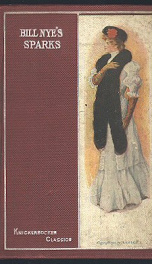
bill nyes sparks
Series:
Unknown
Year:
Unknown
Raiting:
4/5
Purchase of this book includes free trial access to www.million-books.com where you can read more than a million books for free. This is an OCR edition with typos. Excerpt from book: mT NAME is Veritas. I write for the papers. I am quite an old man and have written my kindly words of advice to the press for many years. I am the friend of the public and the guiding star of the American newspaper. I point out the proper course for a newly-elected member of Congress and show the thoughtless editor the wants of the people. I write on the subject of political economy ; also on both sides of the paper. Sometimes I write on both sides of the question. When I do so I "write over the name of Tax-Payer, but my real name is Veritas. I am the man who first suggested the culvert at the Jim street crossing, so that the water would run off toward the pound after a rain. With my ready penready, and trenchant also, as I may sayI have, in my poor, weak way, suggested a great many things which might otherwise have remained for many years unsug- gested. I am the man who annually calls for a celebration of the Fourth of July in our little town, and asks for some young elocutionist to be selected by the committee, whose duty it shall be to read the Declaration of Independence in a shrill voice to those who yearn to be thrillel through and through with patriotism. Did I not speak through the columns of the press in clarion tones for a proper observance of our nation's great natal day in large gothic extended caps, the nation's starry banner would remain furled and the greased pig would continue to crouch in his lair. With the aid of my genial co-workers Tax-Payer, Old Settler, Old Subscriber, Constant Reader, U. L. See, Fair Play, and Mr. Pro Bono Publico, I have made the world a far more desirable place in which to live than it would otherwise have been. My co-laborer, Mr. Tax-Payer, is an old contributor to the paper, but he is not really a taxpayer. He uses this sig... --This text refers to the Paperback edition.
Show more
add to favoritesadd In favorites
Book list

nye and rileys railway guide
Series:
Unknown
Year:
Unknown
Raiting:
4.5/5
This volume is produced from digital images created through the University of Michigan University Library's large-scale digitization efforts. The Library seeks to preserve the intellectual content of items in a manner that facilitates and promotes a variety of uses. The digital reformatting process results in an electronic version of the original text that can be both accessed online and used to create new print copies. The Library also understands and values the usefulness of print and makes reprints available to the public whenever possible. This book and hundreds of thousands of others can be found in the HathiTrust, an archive of the digitized collections of many great research libraries. For access to the University of Michigan Library's digital collections, please see http://www.lib.umich.edu and for information about the HathiTrust, please visit http://www.hathitrust.org --This text refers to an out of print or unavailable edition of this title.
Show more
add to favoritesadd In favorites

bill nyes sparks
Series:
Unknown
Year:
Unknown
Raiting:
4/5
Purchase of this book includes free trial access to www.million-books.com where you can read more than a million books for free. This is an OCR edition with typos. Excerpt from book: mT NAME is Veritas. I write for the papers. I am quite an old man and have written my kindly words of advice to the press for many years. I am the friend of the public and the guiding star of the American newspaper. I point out the proper course for a newly-elected member of Congress and show the thoughtless editor the wants of the people. I write on the subject of political economy ; also on both sides of the paper. Sometimes I write on both sides of the question. When I do so I "write over the name of Tax-Payer, but my real name is Veritas. I am the man who first suggested the culvert at the Jim street crossing, so that the water would run off toward the pound after a rain. With my ready penready, and trenchant also, as I may sayI have, in my poor, weak way, suggested a great many things which might otherwise have remained for many years unsug- gested. I am the man who annually calls for a celebration of the Fourth of July in our little town, and asks for some young elocutionist to be selected by the committee, whose duty it shall be to read the Declaration of Independence in a shrill voice to those who yearn to be thrillel through and through with patriotism. Did I not speak through the columns of the press in clarion tones for a proper observance of our nation's great natal day in large gothic extended caps, the nation's starry banner would remain furled and the greased pig would continue to crouch in his lair. With the aid of my genial co-workers Tax-Payer, Old Settler, Old Subscriber, Constant Reader, U. L. See, Fair Play, and Mr. Pro Bono Publico, I have made the world a far more desirable place in which to live than it would otherwise have been. My co-laborer, Mr. Tax-Payer, is an old contributor to the paper, but he is not really a taxpayer. He uses this sig... --This text refers to the Paperback edition.
Show more
add to favoritesadd In favorites
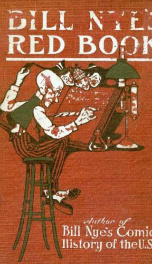
bill nyes red book
Series:
Unknown
Year:
Unknown
Raiting:
2/5
1906. Over one hundred and fifty humorous drawings by J.H. Smith, formerly with Judge. A collection of writings by Edgar Wilson Nye (Bill Nye), American author and journalist. He writes: This is the fourth book that I have published in response to the clamorous appeals of the public. I had long hoped to publish a larger, better, and if possible a redder book than the first; one that would contain my better thoughts; thoughts that I had thought when I was feeling well; thoughts that I had omitted when my thinker was rearing up on its hind feet, if I may be allowed that term; thoughts that sprang forth with a wild whoop and demanded recognition. This book is the result of that hope and that wish. It is my greatest and best book. See other titles by this author available from Kessinger Publishing. --This text refers to the Paperback edition.
Show more
add to favoritesadd In favorites
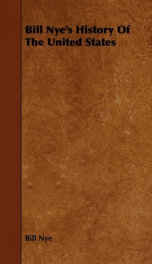
bill nyes history of the united states
Series:
Unknown
Year:
Unknown
Raiting:
2/5
Many of the earliest books, particularly those dating back to the 1900s and before, are now extremely scarce and increasingly expensive. We are republishing these classic works in affordable, high quality, modern editions, using the original text and artwork.
Show more
add to favoritesadd In favorites

bill nyes comic history of england
Series:
Unknown
Year:
Unknown
Raiting:
2/5
from the PREFACE: The readers of this volume will share our regret that the preface cannot be written by Mr. Nye, who would have introduced his volume with a characteristically appropriate and humorous foreword in perfect harmony with the succeeding narrative. We need only say that this work is in the author's best vein, and will prove not only amusing, but instructive as well; for the events, successions, dates, etc., are correct, and the trend of actual facts is adhered to. Of course, these facts are "embellished," as Mr. Nye would say, by his fancy, and the leading historical characters are made to play in fantastic roles. Underneath all, however, a shrewd knowledge of human nature is betrayed, which unmasks motives and reveals the true inwardness of men and events with a humorous fidelity. The unfortunate illness to which Mr. Nye finally succumbed prevented the completion of his history beyond the marriage of Henry VIII. to Anne Boleyn. TABLE OF CONTENTS: CHAPTER I.INVASION OF CAESAR: THE DISCOVERY OF TIN AND CONSEQUENT ENLIGHTENMENT OF BRITAIN CHAPTER II.THE VARIOUS ROMAN YOKES: THEIR GROWTH, DEGENERATION, AND FINAL ELIMINATION CHAPTER III.THE ADVENT OF THE ANGLES: CAUSES WHICH LED TO THE REHABILITATION OF BRITAIN ON NEW LINES CHAPTER IV.THE INFLUX OF THE DANES: FACTS SHOWING CONCLUSIVELY THEIR INFLUENCE ON THE BRITON OF TO-DAY CHAPTER V.THE TROUBLOUS MIDDLE AGES: DEMONSTRATING A SHORT REIGN FOR THOSE WHO TRAVEL AT A ROYAL GAIT CHAPTER VI.THE DANISH OLIGARCHY: DISAFFECTIONS ATTENDING CHRONIC USURPATION PROCLIVITIES CHAPTER VII.OTHER DISAGREEABLE CLAIMANTS: FOREIGN FOIBLES INTRODUCED, ONLY TO BE EXPUNGED WITH CHARACTERISTIC PUGNACITY CHAPTER VIII.THE NORMAN CONQUEST: COMPLEX COMMINGLING OF FACETIOUS ACCORD AND IMPLACABLE DISCORD CHAPTER IX.THE FEUDAL SYSTEM: SUCCESSFUL INAUGURATION OF HOMOGENEAL METHODS FOR RESTRICTING INCOMPATIBLE DEMAGOGUES CHAPTER X.THE AGE OF CHIVALRY: LIGHT DISSERTATION ON THE KNIGHTS-ERRANT, MAIDS, FOOLS, PRELATES, AND OTHER NOTORIOUS CHARACTERS OF THAT PERIOD CHAPTER XICONQUEST OF IRELAND: UNCOMFORTABLE EFFECTS FOLLOWING THE CULTIVATION OF AN ACQUISITORIAL PROPENSITY CHAPTER XII.MAGNA CHARTA INTRODUCED: SLIGHT DIFFICULTIES ENCOUNTERED IN OVERCOMING AN UNPOPULAR AND UNREASONABLE PREJUDICE CHAPTER XIII.FURTHER DISAGREEMENTS RECORDED: ILLUSTRATING THE AMIABILITY OF THE JEW AND THE PERVERSITY OF THE SCOT CHAPTER XIV.IRRITABILITY OF THE FRENCH: INTERMINABLE DISSENSION, ASSISTED BY THE PLAGUE, CONTINUES REDUCING THE POPULATION CHAPTER XV.MORE SANGUINARY TRIUMPHS: ONWARD MARCH OF CIVILIZATION GRAPHICALLY DELINEATED WITH THE HISTORIAN'S USUAL COMPLETENESS CHAPTER XVI.UNPLEASANT CAPRICES OF ROYALTY: INTRODUCTION OF PRINTING AS A SUBSIDIARY AID IN THE PROGRESS OF EMANCIPATIONCHAPTER XVII.BIOGRAPHY OF RICHARD III.: BEING AN ALLEGORICAL PANEGYRIC OF THE INCONTROVERTIBLE MACHINATIONS OF AN EGOTISTICAL USURPER CHAPTER XVIII.DISORDER STILL THE POPULAR FAD: GENERAL ADMIXTURE OF PRETENDERS, RELIGION, POLITICS, AND DISGRUNTLED MONARCHS --This text refers to the Kindle Edition edition.
Show more
add to favoritesadd In favorites

bill nyes chestnuts old and new
Series:
Unknown
Year:
Unknown
Raiting:
2.5/5
"Caxton Edition." Numerous illustrations.
Show more
add to favoritesadd In favorites

bill nyes chestnuts old and new latest gathering
Series:
Unknown
Year:
Unknown
Raiting:
4.5/5
Show more
add to favoritesadd In favorites

bill nye and boomerang or the tale of a meek eyed mule and some other liter
Series:
Unknown
Year:
Unknown
Raiting:
3.5/5
Show more
add to favoritesadd In favorites
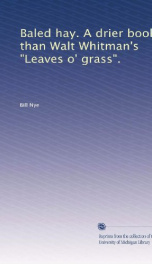
baled hay a drier book than walt whitmans leaves o grass
Series:
Unknown
Year:
Unknown
Raiting:
3.5/5
This volume is produced from digital images created through the University of Michigan University Library's large-scale digitization efforts. The Library seeks to preserve the intellectual content of items in a manner that facilitates and promotes a variety of uses. The digital reformatting process results in an electronic version of the original text that can be both accessed online and used to create new print copies. The Library also understands and values the usefulness of print and makes reprints available to the public whenever possible. This book and hundreds of thousands of others can be found in the HathiTrust, an archive of the digitized collections of many great research libraries. For access to the University of Michigan Library's digital collections, please see http://www.lib.umich.edu and for information about the HathiTrust, please visit http://www.hathitrust.org
Show more
add to favoritesadd In favorites
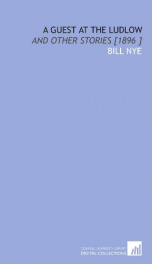
a guest at the ludlow and other stories
Series:
Unknown
Year:
Unknown
Raiting:
3.5/5
Originally published in 1896. This volume from the Cornell University Library's print collections was scanned on an APT BookScan and converted to JPG 2000 format by Kirtas Technologies. All titles scanned cover to cover and pages may include marks notations and other marginalia present in the original volume.
Show more
add to favoritesadd In favorites
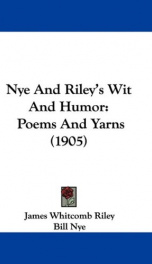
Nye and Riley's Wit and Humor (Poems and Yarns)
Series:
Unknown
Year:
Unknown
Raiting:
4/5
Also Illustrated By E. Zimmerman, Walt McDougall, And Others.
Show more
add to favoritesadd In favorites
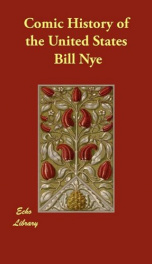
Comic History of the United States
Series:
Unknown
Year:
Unknown
Raiting:
3/5
First published 1894. Bill Nye was a journalist and humourist who also wrote several books including "Bill Nye's History of England".
Show more
add to favoritesadd In favorites
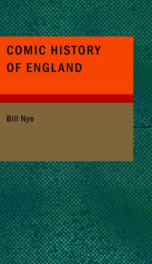
Comic History of England
Series:
Unknown
Year:
Unknown
Raiting:
3.5/5
A recital of the many eventful events which transpired in England from the Druids to Henry VIII. --This text refers to an alternate Paperback edition.
Show more
add to favoritesadd In favorites
What readers are saying
What do you think? Write your own comment on this author!
write a commentif you like Nye Bill try:
readers also enjoyed
What readers are saying
What do you think? Write your own comment on this author!
write a commentGenre
if you like Nye Bill try:
readers also enjoyed
Do you want to exchange books? It’s EASY!
Get registered and find other users who want to give their favourite books to good hands!
